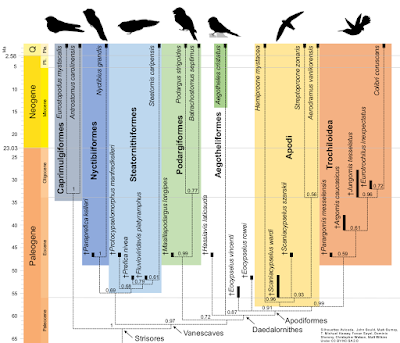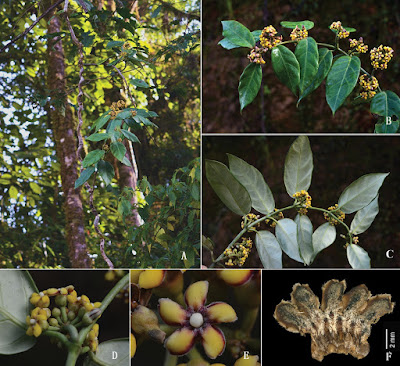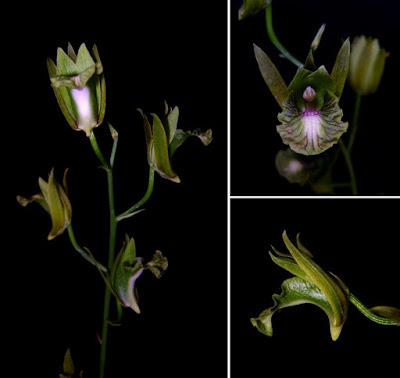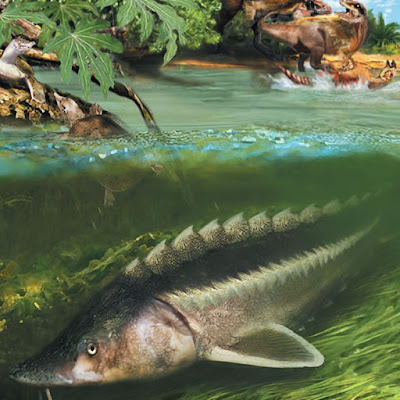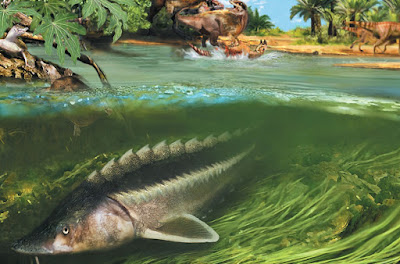[Most Recent Entries] [Calendar View]
Tuesday, September 3rd, 2019
| Time | Event | ||||
| 8:15a | [Ornithology • 2019] Total-Evidence Framework Reveals Complex Morphological Evolution in Nightbirds (Strisores)
Abstract Strisores is a clade of neoavian birds that include diurnal aerial specialists such as swifts and hummingbirds, as well as several predominantly nocturnal lineages such as nightjars and potoos. Despite the use of genome-scale molecular datasets, the phylogenetic interrelationships among major strisorean groups remain controversial. Given the availability of next-generation sequence data for Strisores and the clade’s rich fossil record, we reassessed the phylogeny of Strisores by incorporating a large-scale sequence dataset with anatomical data from living and fossil strisoreans within a Bayesian total-evidence framework. Combined analyses of molecular and morphological data resulted in a phylogenetic topology for Strisores that is congruent with the findings of two recent molecular phylogenomic studies, supporting nightjars (Caprimulgidae) as the extant sister group of the remainder of Strisores. This total-evidence framework allowed us to identify morphological synapomorphies for strisorean clades previously recovered using molecular-only datasets. However, a combined analysis of molecular and morphological data highlighted strong signal conflict between sequence and anatomical data in Strisores. Furthermore, simultaneous analysis of molecular and morphological data recovered differing placements for some fossil taxa compared with analyses of morphological data under a molecular scaffold, highlighting the importance of analytical decisions when conducting morphological phylogenetic analyses of taxa with molecular phylogenetic data. We suggest that multiple strisorean lineages have experienced convergent evolution across the skeleton, obfuscating the phylogenetic position of certain fossils, and that many distinctive specializations of strisorean subclades were acquired early in their evolutionary history. Despite this apparent complexity in the evolutionary history of Strisores, our results provide fossil support for aerial foraging as the ancestral ecological strategy of Strisores, as implied by recent phylogenetic topologies derived from molecular data. Keywords: Strisores; avian; phylogeny; evolution; morphology; total-evidence Conclusions: The present work represents one of the most comprehensive studies on strisorean phylogeny to date in terms of character sampling, combining a genome-scale molecular dataset and a large sample of fossil taxa in an attempt to resolve the internal relationships of this enigmatic clade of birds. The preferred topology found in this study places Caprimulgidae, (Steatornithidae + Nyctibiidae), and Podargidae as successively closer relatives of Daedalornithes, which is congruent with the results of some other recent phylogenomic analyses of Strisores. We also identified possible morphological synapomorphies that unite strisorean clades recovered using molecular data and potential fossil evidence that may support aerial foraging as the ancestral ecology of Strisores, as implied by molecular topologies. Contrary to expectations, however, combining morphological and molecular datasets did not increase confidence in any specific phylogenetic topology, despite the inclusion of a phylogenetically diverse range of well-known fossil taxa. We attribute this surprising result to high levels of morphological homoplasy in Strisores, early morphological diversification possibly obscuring ancestral morphologies in known fossil strisoreans, and the relatively small size of existing morphological matrices pertaining to strisoreans. Further refinement of phylogenomic methods may also advance future estimates of strisorean phylogeny. Our findings suggest that improved understanding of morphological evolution in strisoreans will be contingent on the discovery of even older fossil taxa that retain more plesiomorphic morphologies, as well as more comprehensive character sampling in morphological datasets. Albert Chen, Noor D. White, Roger B.J. Benson, Michael J. Braun and Daniel J. Field. 2019. Total-Evidence Framework Reveals Complex Morphological Evolution in Nightbirds (Strisores). Diversity. 11(9); 143. DOI: 10.3390/d11090143 | ||||
| 1:54p | [Botany • 2019] Marsdenia yarlungzangboensis (Apocynaceae: Asclepiodoideae) • A New Species from Xizang, China
Abstract Marsdenia yarlungzangboensis (Apocynaceae, Asclepiadoideae), a new species from Motuo County, southeastern Xizang of China, is described and illustrated. It is morphologically similar to M. medogensis, M. tenii and M. yuei, the major differences between the new species and the morphological relatives are outlined and discussed. A diagnostic key to the new species and its closely related species in China is provided. Keywords: Marsdenia, Marsdenia yarlungzangboensis, new species, China
Marsdenia yarlungzangboensis C.Liu, J.D.Ya & Y.H.Tan, sp. nov. Diagnosis: Marsdenia yarlungzangboensis is morphologically similar to M. medogensis, M. tenii and M. yuei, but differs from M. medogensis in inflorescences pubescent; sepals suborbicular; corolla yellow, throat red and densely pilose, shorter lobes and reddish outside, apex emarginate, margin reddish and ciliate; corona lobes triangular, to base of anthers; stigma head hemispherical; and differs from M. tenii in leaf blades elliptic; sepals suborbicular; corolla yellow, throat red, lobes reddish outside, margin reddish; stigma head hemispherical, conspicuously exserted from anther appendages and corolla tube; and also differs from M. yuei in leaf blades elliptic; inflorescences unbranched and pubescent; sepals suborbicular; corolla yellow, throat red and densely pilose; lobes ovate, apex emarginate; corona lobes to base of anthers. .... Distribution and habitat: Marsdenia yarlungzangboensis grows at the margins of subtropical evergreen broad-leaved forest with main community types of Castanopsis echinocarpa J. D. Hooker & Thomson ex Miquel and Quercus gambleana A. Camus, Renqinbeng, Motuo County, Xizang, China, at an elevation of 1800–2100 m. Etymology: The specific epithet ‘yarlungzangboensis’ is derived from the type locality, Yarlung Zangbo Grand Canyon, Motuo County, southeast Xizang, China. Vernacular name: Yǎ Lǔ Zàng Bù Niú Nǎi Cài (Chinese pronunciation); 雅鲁藏布牛奶菜 (Chinese name). Cheng Liu, Ji-Dong Ya, Yun-Hong Tan, Hua-Jie He, Gui-Jun Dong and De-Zhu Li. 2019. Marsdenia yarlungzangboensis (Apocynaceae, Asclepiadoideae), A New Species from Xizang, China. PhytoKeys. 130: 85-92. DOI: 10.3897/phytokeys.130.34152 | ||||
| 2:43p | [Botany • 2019] Eulophia lagaligo (Orchidaceae) • A New Name for An Overlooked Species of Eulophia from Wallacea
Eulophia bicolor described by Blume is an illegitimate name for a species that has generally been considered synonymous with E. nuda. The former should be recognized as a distinct species, as it differs in having different spur characteristics, a narrower column, and an anther cap with an elongated protuberance. It is here given a new name, E. lagaligo. Keywords: Sulawesi, Lesser Sunda Islands, Indonesia, Monocots
Eulophia lagaligo Metusala, nom. nov. Replaced name: Eulophia bicolor Blume (1859: 151), nom. illeg. (non Dalzell, 1851). Type:—INDONESIA. Timor, Zippelius s.n. (holotype: L!—photo seen, barcode L0061229). Heterotypic synonym: Eulophia bicolor Blume var. celebica Smith (1922: 71). (Syntype: L!, barcode L0061231). Diagnosis:— Eulophia lagaligo is morphologically close to Eulophia nuda, but differs in having a downwards-pointing spur formed by the lip and the column-foot (versus a backwards-pointing spur formed by the column-foot only, Fig. 4), a narrower column (2–2.5 versus 4–5 mm wide), and an anther cap with an elongated, horn-like protuberance (versus an anther cap with two short protuberances, Fig. 5). ... Distribution:— The distribution of Eulophia lagaligo so far appears to be restricted to two islands in Wallacea. During the expedition in 2008, living plants were found in relatively open habitat in Cani Sirenreng, South Sulawesi at 100–600 m. Previous records of this taxon are from Gunung Pasangmalambe, South Sulawesi (Smith 1922) and Timor Island, Lesser Sunda islands (Blume 1859). Etymology:— The specific epithet refers to La Galigo, a 14th century poetic text in the ancient language of the Bugis people from South Sulawesi, which has been recognized by UNESCO as Memory of the World documentary heritage, and is one of the most voluminous literary work in the world. Destario Metusala. 2019. A New Name for an Overlooked Species of Eulophia (Orchidaceae) from Wallacea. Zootaxa. 415(4); 217–224. DOI: 10.11646/phytotaxa.415.4.6 | ||||
| 2:54p | [PaleoIchthyology • 2019] Anchiacipenser acanthaspis • A Rare, Articulated Sturgeon (Chondrostei: Acipenseriformes) from the Upper Cretaceous of Dinosaur Provincial Park, Alberta, Canada
Abstract Although fragmentary remains of sturgeon, such as scutes and pectoral spines, are relatively common in fossil deposits, articulated fossilized skeletons are rare in Upper Cretaceous sediments of North America. Currently, there are four extinct species referred to Acipenseridae reported from the Upper Cretaceous of North America; two of them (†Acipenser eruciferus and †A. albertensis) are of doubtful validity because they are based on isolated elements that are probably not diagnostic. Only two species, †Priscosturion longipinnis and †Protoscaphirhynchus squamosus, have been described based on articulated skeletons. In June 2016, an articulated sturgeon specimen was discovered in the Campanian Dinosaur Park Formation of Dinosaur Provincial Park, Alberta, Canada. This specimen preserves the skull and anterior half to two-thirds of the body but is missing the pelvic, dorsal, anal, and caudal fins. This new specimen cannot be included in any of the previously named taxa, so we describe it here as a new genus and species, †Anchiacipenser acanthaspis. A combination of several characters allows us to diagnose the new sturgeon from Dinosaur Provincial Park as a new taxon, including the dermal cranial bones being strongly ornamented with straight and anastomosing ridges, the dorsal scutes being large and laterally expanded and bearing median spines, and the presence of an extensive cover of smaller dermal scales on the flanks. A phylogenetic analysis indicates that this new taxon belongs in Acipenseridae, although its precise relationships within this clade are not clear. Class OSTEICHTHYES Huxley, 1880 Subclass ACTINOPTERYGII Cope, 1887 Infraclass CHONDROSTEI Müller, 1845 Order ACIPENSERIFORMES Berg, 1940 Family ACIPENSERIDAE Bonaparte, 1831 †ANCHIACIPENSER, gen. nov. Type and Only Known Species— †Anchiacipenser acanthaspis, sp. nov. Diagnosis— As for type and only known species. Derivation of Name:— From the Greek word ‘anchi,’ meaning near or close, and the Latinized Greek word ‘acipenser,’ relating to sturgeons, referring to the phylogenetic position of this genus as a member of the family Acipenseridae. Gender is masculine. †ANCHIACIPENSER ACANTHASPIS, sp. nov. Etymology:— From the Greek words ‘acantha’ meaning thorn or spine, and ‘aspis’ meaning shield, in reference to the strong spines that are present on most of the dorsal scutes. Hiroki Sato, Alison M. Murray, Oksana Vernygora and Philip J. Currie. 2018. A Rare, Articulated Sturgeon (Chondrostei: Acipenseriformes) from the Upper Cretaceous of Dinosaur Provincial Park, Alberta, Canada. Journal of Vertebrate Paleontology. 38(4); (1)–(15). DOI: 10.1080/02724634.2018.1488137 |
| << Previous Day |
2019/09/03 [Calendar] |
Next Day >> |
